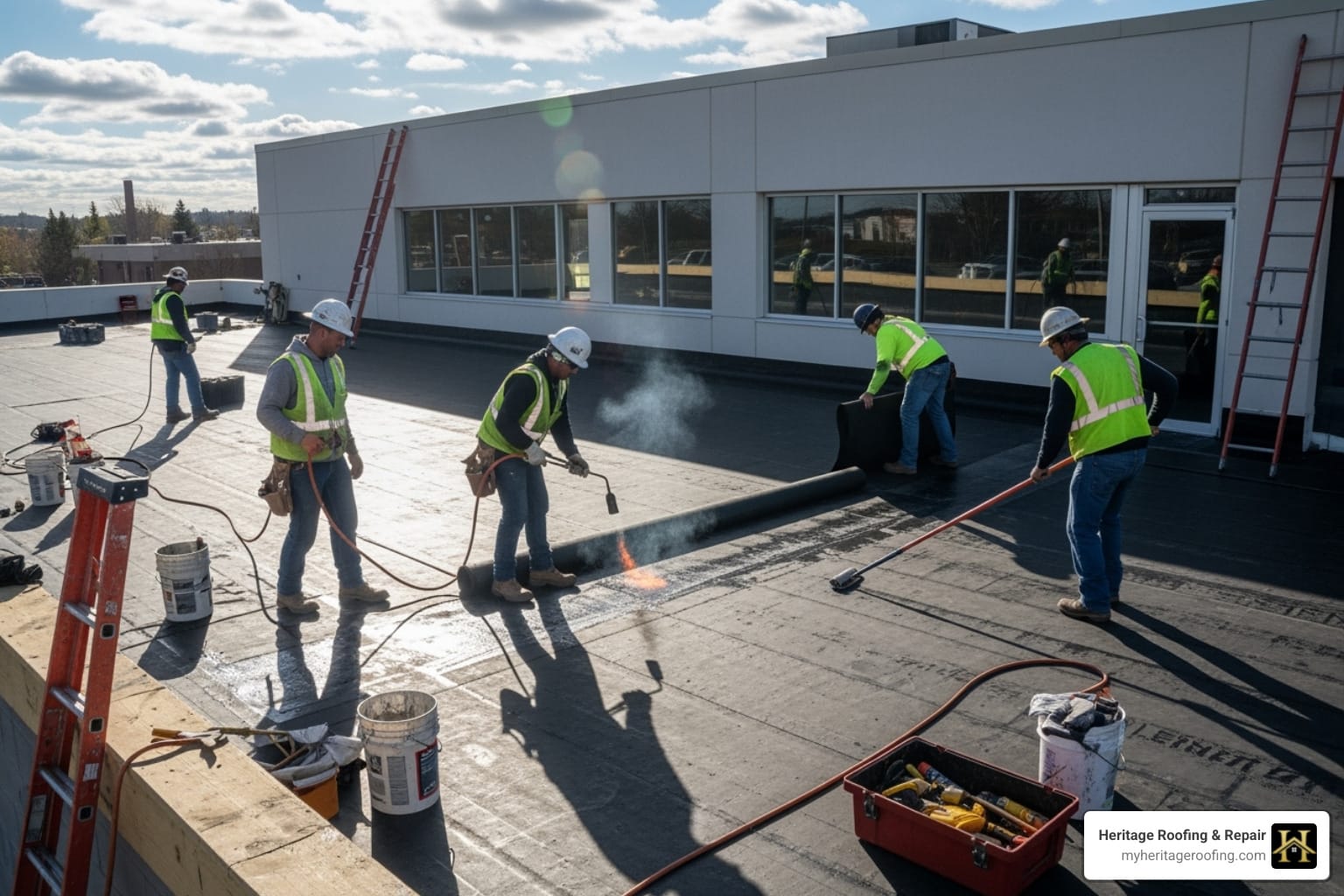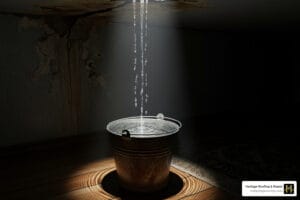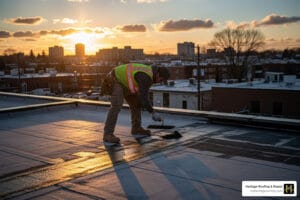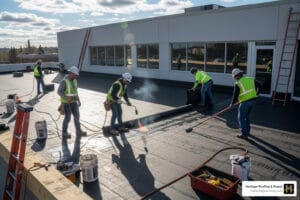Protecting Your Investment from the Top Down
A commercial flat roof installation is a significant investment in your property’s longevity and safety. As a business owner, your roof is a critical asset, and a failing one can lead to expensive damages and operational downtime. Understanding the installation process is the first step toward making a smart choice that protects your business for decades. For business owners in Arkansas, securing dependable commercial roofing solutions is key to safeguarding your investment against our unique weather challenges.
This guide covers everything from material selection to final inspection, helping you navigate the complexities of a new roof and make an informed decision.
I’m Rex Wisdom, owner of Heritage Roofing & Repair. My family has provided commercial flat roof installation services in Northwest Arkansas for over 50 years. We bring a hands-on approach and decades of experience to ensure superior workmanship and customer satisfaction.
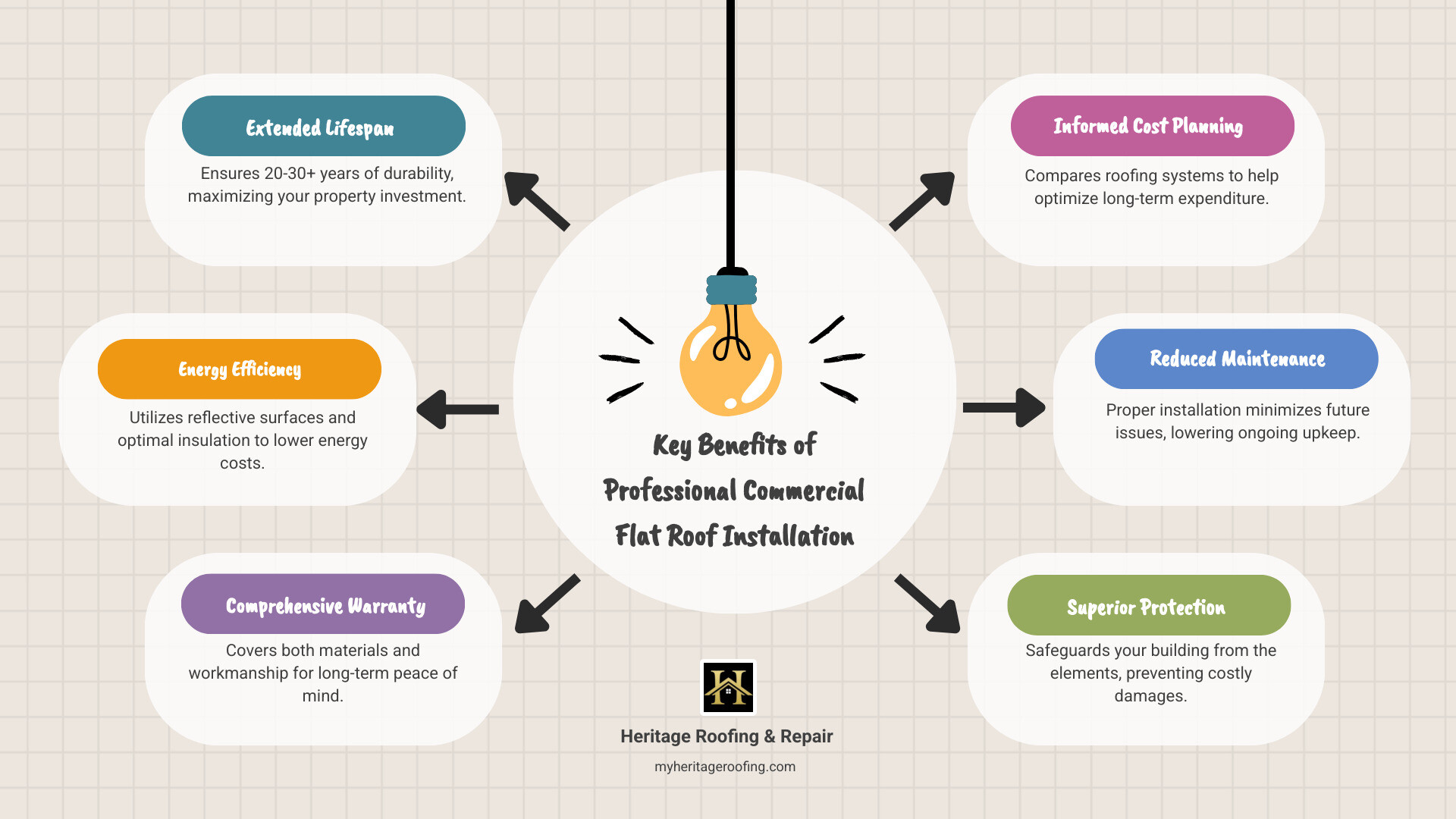
Before the First Nail: Critical Pre-Installation Planning
Proper planning is the foundation of a successful commercial flat roof installation. This crucial pre-installation phase ensures your new roof will perform for decades, meet structural requirements, and comply with local regulations. Skipping this groundwork is a gamble that can lead to premature failures and costly repairs. It involves a thorough structural assessment, roof deck preparation, drainage design, and securing all necessary permits.
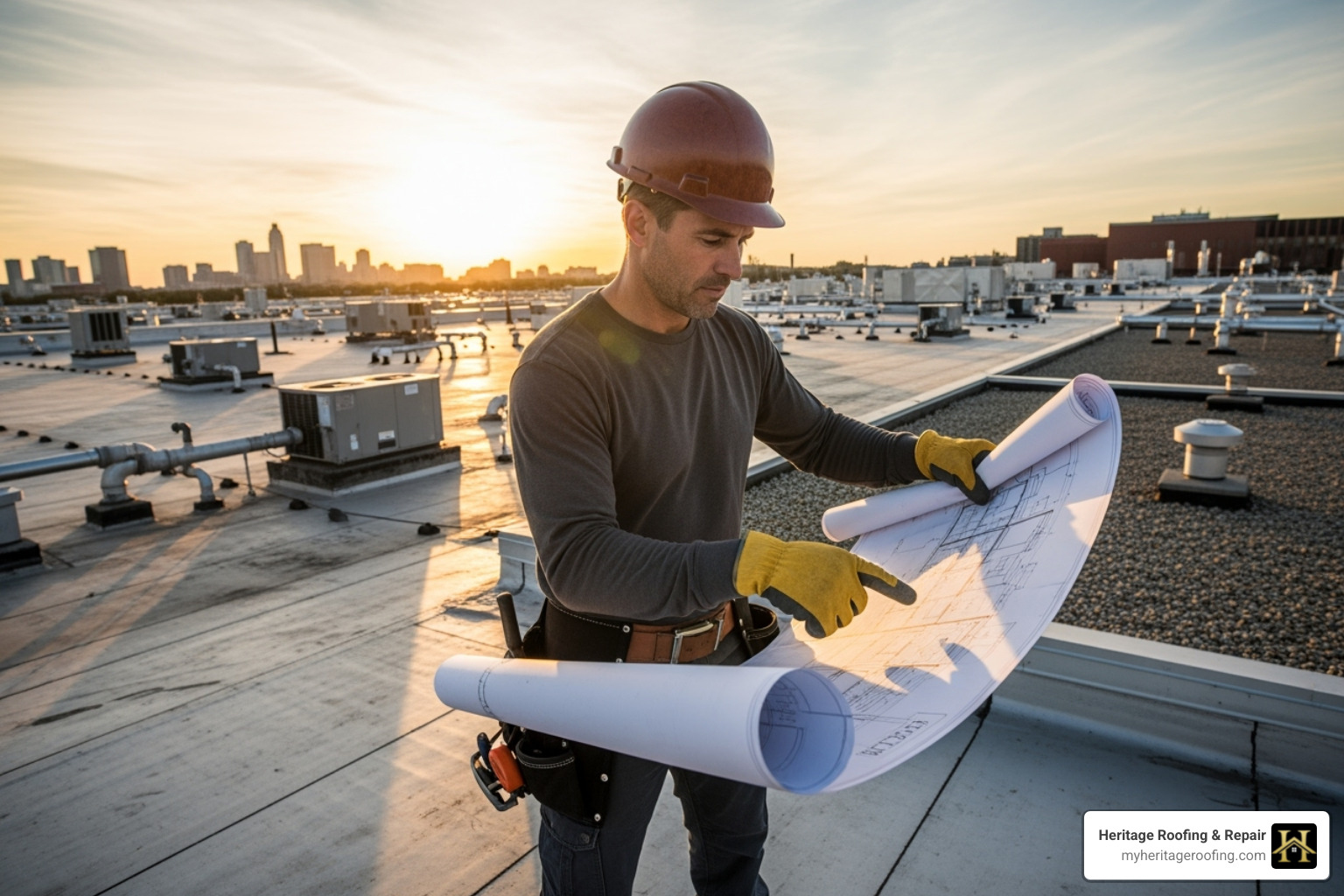
At Heritage Roofing & Repair, we always recommend hiring a licensed roofing contractor or inspector for this assessment. Their expertise can identify potential issues before they become major problems, saving you thousands in the long run.
Key Structural Considerations for Your New Roof
Your flat roof is an integral part of your building’s structure. Before installation, we must assess several key components:
- Roof Load Capacity: Can the structure support the weight of the new system, including insulation and equipment? Some materials are much heavier than others.
- HVAC Unit Placement: Heavy units require stable platforms and proper flashing to prevent leaks. Their placement must be factored into the structural plan from the start.
- Parapet Wall Condition: These perimeter walls are vital for securing the roofing membrane, so we inspect them for stability and integrity.
- Insulation Requirements: We determine the necessary R-value to meet energy codes and optimize your building’s thermal performance, often using efficient materials like polyisocyanurate (polyiso).
- Vapor Retarders: This layer prevents moisture from migrating into the roof assembly, which can compromise insulation and cause leaks.
- Substrate Condition: The surface beneath the new roof must be clean, dry, and structurally sound. Any damage found after tear-off must be repaired immediately.
How Climate and Building Use Influence Your Choice
The “best” flat roof is not a one-size-fits-all solution. Your local climate and building’s purpose are major factors in selecting the right system.
- Local Weather: Arkansas’s intense summer sun and severe storms demand UV-resistant, waterproof, and wind-resistant materials. Proper drainage is also critical for handling heavy rainfall.
- UV Exposure: Reflective “cool roofs” are popular for resisting UV degradation and reducing energy costs by reflecting heat. The Cool Roof Rating Council provides data on material reflectivity.
- Foot Traffic: Roofs with frequent maintenance access need durable, puncture-resistant materials like modified bitumen or robust single-ply membranes.
- Chemical Exposure: Restaurants or industrial facilities may produce fumes containing oils and chemicals. PVC roofing offers excellent resistance to these substances.
- Energy Efficiency Goals: White, reflective materials like TPO and PVC can significantly lower cooling loads and reduce energy consumption.
Choosing Your Shield: A Deep Dive into Flat Roofing Materials
Selecting the right roofing system is crucial for your budget and your building’s long-term performance. With modern materials better than ever, there’s a system to fit every need, from budget-friendly efficiency to premium durability. Did you know TPO currently leads the market, capturing 40% of new construction projects?
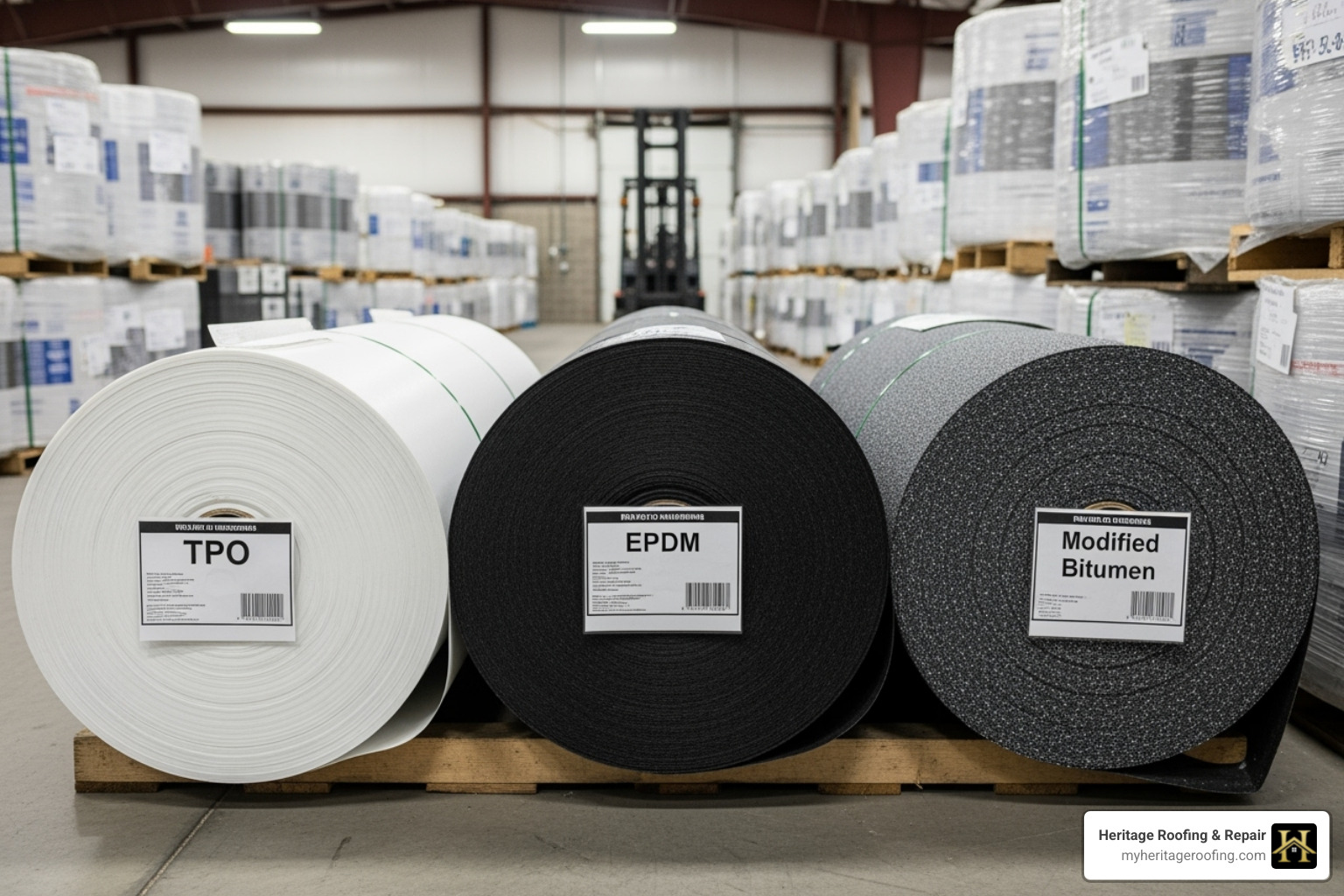
After five decades in the business, I’ve seen how the right choice can save thousands in energy costs and repairs, while the wrong one becomes a costly headache. Let’s break down the most popular options.
Single-Ply Membranes: TPO, PVC, and EPDM
These factory-manufactured sheets are engineered for flexibility and strength, moving with your building as it settles and temperatures change.
- TPO Roofing: The crowd favorite for its balance of cost-effectiveness and performance. This white, reflective membrane keeps buildings cool, and its heat-welded seams create a monolithic, waterproof barrier. A quality TPO system can last 20-30 years, but proper seam installation is critical.
- PVC Roofing: TPO’s tougher cousin. It costs slightly more but offers superior resistance to chemicals, grease, and fire, making it ideal for restaurants and industrial facilities. Like TPO, it features heat-welded seams and can last up to 30 years.
- EPDM Rubber Roofing: The time-tested veteran, with some installations from the 1960s still in service. This durable black rubber membrane can last 30+ years. While its black color absorbs heat, its longevity is best. It can be installed using adhered or mechanically fastened systems.
Traditional Systems: BUR and Modified Bitumen
These multi-layer systems have protected commercial buildings for over a century and are known for their toughness.
- Built-Up Roofing (BUR): The classic “tar and gravel” roof. Built-Up Roofing (BUR) uses multiple layers of roofing felt and asphalt, topped with gravel. This creates an incredibly durable, low-maintenance shield with excellent UV protection.
- Modified Bitumen: A modern take on BUR, this system adds synthetic polymers to asphalt for improved flexibility in cold temperatures, reducing cracks. It offers excellent puncture resistance, making it ideal for roofs with high foot traffic. It can be installed via torch-down or self-adhered methods and typically lasts 20-30 years.
Comparing Commercial Flat Roofing Systems
| Material | Avg. Cost/Sq. Ft. | Avg. Lifespan | Key Advantage | Key Disadvantage |
|---|---|---|---|---|
| TPO | $3.50 – $14.00 | 20-30 Years | Energy Efficient & Cost-Effective | Seam integrity is critical |
| EPDM | $3.25 – $14.75 | 30+ Years | Extremely Durable & Weather Resistant | Black color absorbs heat |
| PVC | $4.00 – $12.00 | 20-30 Years | Chemical & Fire Resistant | Can be less flexible in cold |
| Mod. Bitumen | $9.50 – $14.50 | 20-30 Years | High Puncture Resistance | Torch-down install requires expertise |
| Metal | $8.00 – $18.00 | 30+ Years | Longest Lifespan & Durable | Higher initial cost |
The right choice depends on your budget, building use, and long-term goals. Our experience can help you find the perfect match for your specific situation.
The 8-Step Professional Commercial Flat Roof Installation Process
A professional commercial flat roof installation follows a meticulous, multi-stage process to guarantee a watertight and long-lasting result. Each step builds upon the last, creating a system that will protect your business for decades.
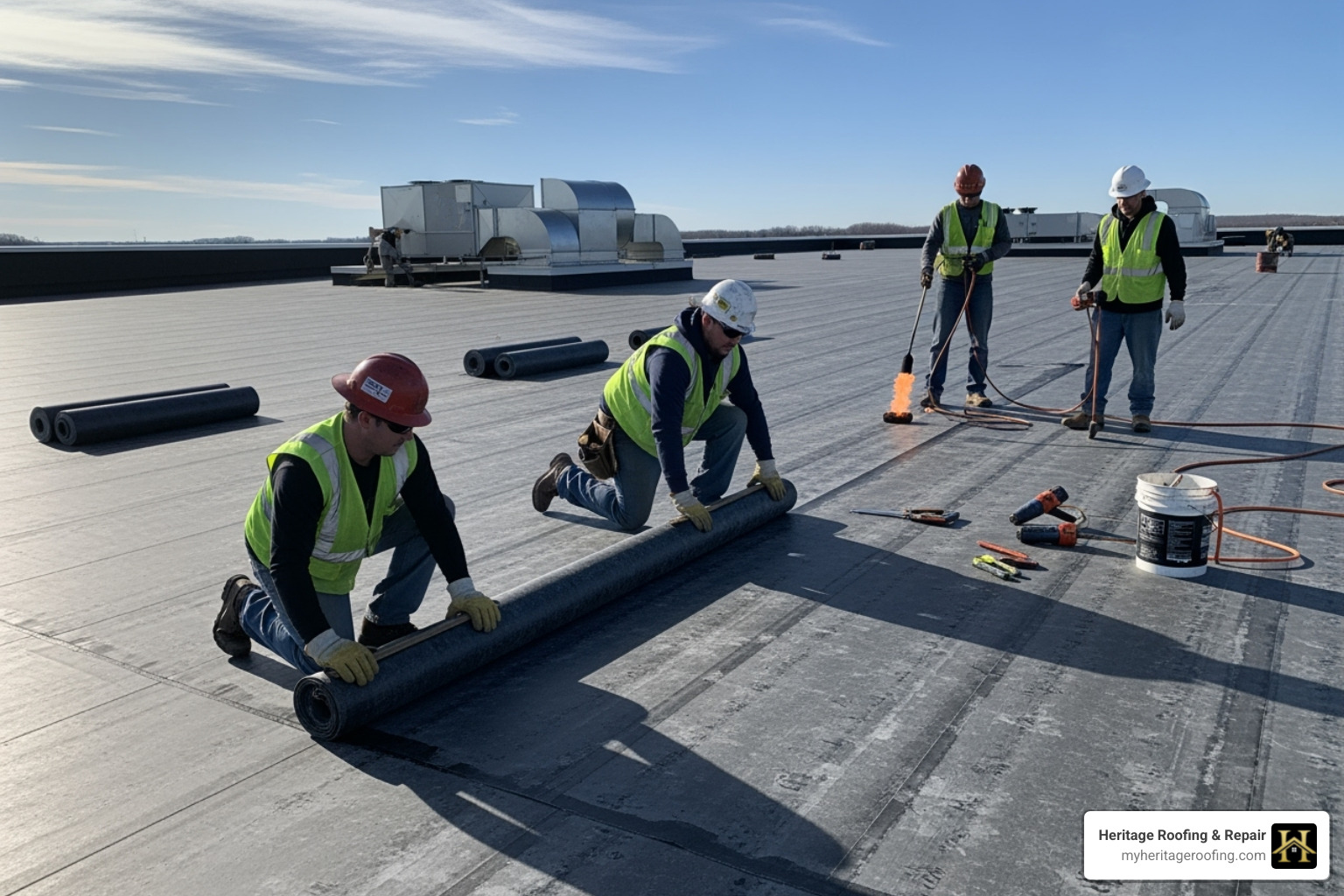
The 8 Key Stages of Installation:
- Initial Inspection & Assessment
- Design & Planning
- Existing Roof Removal
- Structural Repairs & Insulation Installation
- Waterproof Membrane Installation
- Flashing & Edge Detailing
- Seam Welding/Adhesion
- Final Quality Assurance Inspection
Stage 1-4: Tear-Off, Inspection, and Preparation
The foundation of a great roof begins here. Existing Roof Removal is a revealing step, often uncovering hidden issues like water damage or soft spots in the substrate. During Substrate Inspection & Repair, we address these problems immediately. Any necessary Structural Reinforcement is performed to ensure the deck can support the new system against factors like wind uplift. Finally, Insulation Board Installation is critical for energy efficiency. We select insulation with the proper R-Value to meet energy codes and prevent condensation, saving you money and extending your roof’s life.
Stage 5-8: Membrane, Flashing, and Final Checks
This is where the waterproof barrier comes to life. Waterproof Membrane Installation requires precision, whether we’re using TPO, EPDM, or another material. Flashing & Edge Detailing is then carefully applied to all penetrations like vents and HVAC units—these are the most common failure points if not handled correctly. Seam Welding/Adhesion fuses the membrane sheets into a single, monolithic layer. For TPO and PVC, we use hot-air welding to create seams stronger than the material itself. The process concludes with a Final Quality Assurance Inspection and complete Debris Removal, ensuring your new roof meets our high standards and your property is left clean.
Beyond the Build: Maintenance, Challenges, and Local Expertise
Your responsibility doesn’t end once the installation is complete. Proper maintenance is vital for maximizing your roof’s lifespan and performance. A well-maintained roof can easily exceed its expected lifespan, while a neglected one may fail years early.
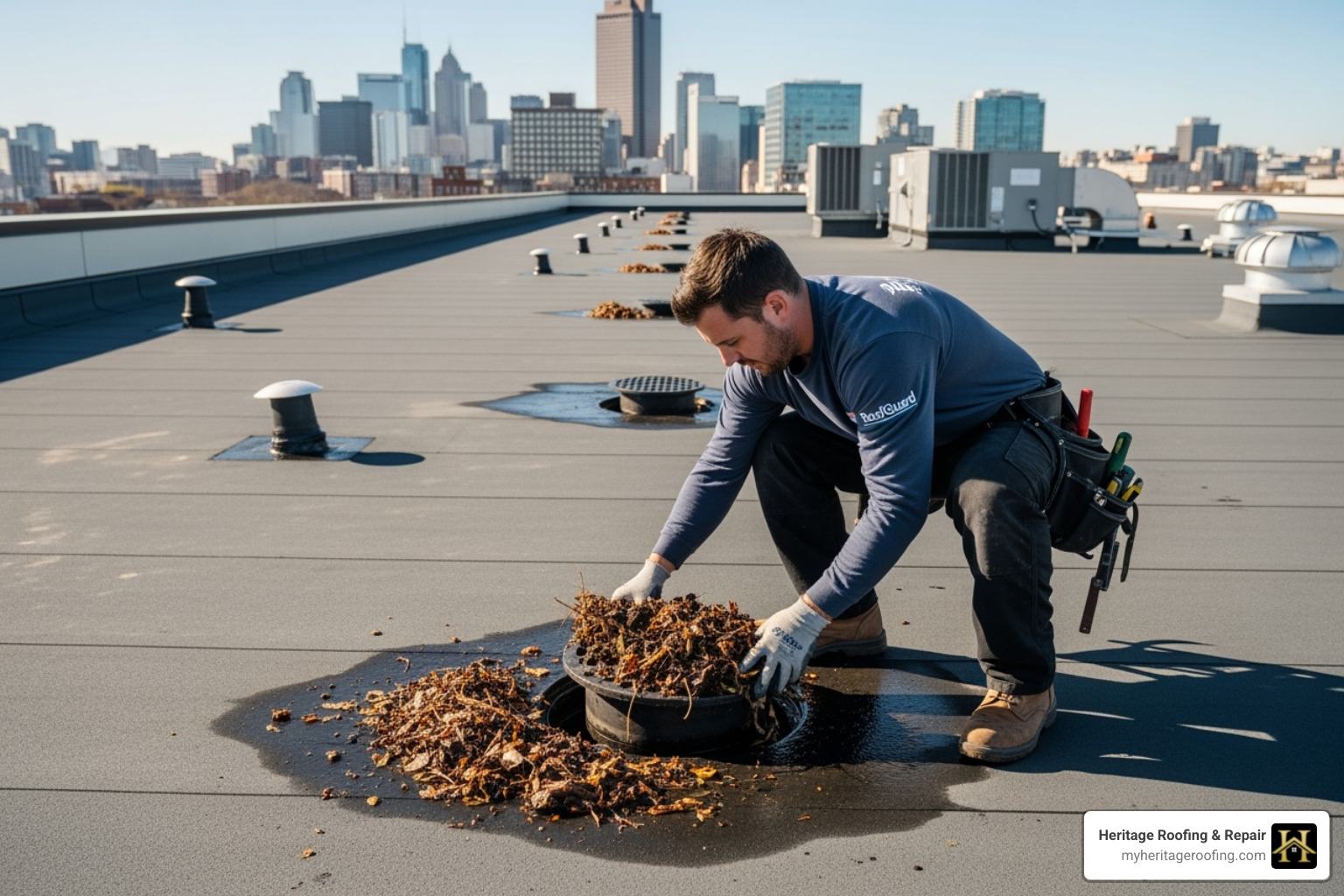
Essential Maintenance for a Long-Lasting Roof
Regular care prevents small issues from becoming costly repairs. Key maintenance tasks include:
- Regular Inspections: At least twice a year (spring and fall) and after major storms to catch issues early.
- Debris Removal: Clearing leaves and branches prevents moisture trapping and blocked drainage.
- Drain Cleaning: Clogged drains are a flat roof’s worst enemy, leading to ponding water that deteriorates the membrane.
- Prompt Leak Repair: Even a small leak can cause significant structural damage and mold if not addressed quickly.
- Seam Checks: Regularly inspect seams for separation or cracking and re-seal minor issues to prevent major leaks.
Common Pitfalls in Commercial Flat Roof Installation
Understanding common mistakes helps you recognize quality workmanship. Watch out for:
- Improper Slope and Drainage: Flat roofs require a slight slope (at least 1/4 inch per foot) to shed water. Ponding water is a major red flag.
- Poor Seam Workmanship: Rushed or inexperienced installation can lead to failed seams, the most vulnerable part of the roof.
- Incorrect Fastener Use: The wrong type or number of fasteners can cause wind uplift or create leak points.
- Incompatible Materials: Chemical reactions between certain materials can cause premature failure.
- Skipping Substrate Repair: Installing a new membrane over a damaged deck is like building on a shaky foundation and leads to failure.
Why Local Expertise Matters in Berryville, AR
For property owners in Northwest Arkansas, a local expert is essential. We understand the regional building codes and how our climate—from intense summer heat to sudden storms—affects roofing materials. When you need a local expert in Berryville, AR, you get a partner who can respond quickly.
Working with Heritage Roofing & Repair means you’re getting a neighbor committed to your long-term success. We’ll be here for maintenance and repairs long after the installation is complete.
Heritage Roofing & Repair
3458 Arkansas State Hwy 221, Berryville, AR 72616
Call us today: (870) 654-1164
Frequently Asked Questions about Commercial Flat Roof Installation
How long does a commercial flat roof installation take?
The timeline for a commercial flat roof installation depends on several factors:
- Size: A small retail building may take a few days, while a large warehouse could take several weeks.
- Weather: Rain and extreme temperatures can cause delays, as most materials require specific conditions for proper installation.
- Complexity: The chosen system and the number of rooftop penetrations (HVAC units, vents, etc.) affect the timeline.
We work efficiently to minimize disruption but never rush the process, as quality is paramount.
Can you install a new flat roof over an old one?
While it’s sometimes possible to do a “roof-over,” we generally don’t recommend it. A complete tear-off is the smarter long-term investment. Tearing off the old roof allows us to inspect the underlying deck for hidden water damage or structural issues. Covering up these problems only makes them worse and more expensive to fix later. A full replacement ensures your new roof has a solid foundation and is often required for full manufacturer warranty coverage.
Your Partner for a Durable and Dependable Roof
A new commercial flat roof installation is a major decision, but with the right partner, it’s an investment in peace of mind. A successful project hinges on three elements: quality materials, expert installation, and consistent maintenance. When these come together, your property is protected for decades.
Your roof is a critical business asset that protects your operations, inventory, and employees from costly disruptions. That’s why our commitment to dependable, affordable, and quality craftsmanship is so important. With over 50 years of experience in Northwest Arkansas, our family-owned business treats your property like our own.
When you partner with Heritage Roofing & Repair, you get a long-term relationship built on trust. We’ll be here for maintenance and repairs long after the job is done.
Ready to secure your investment with a high-performance roof? Explore our commercial roofing services to learn how we can help, or call our experienced team today.
